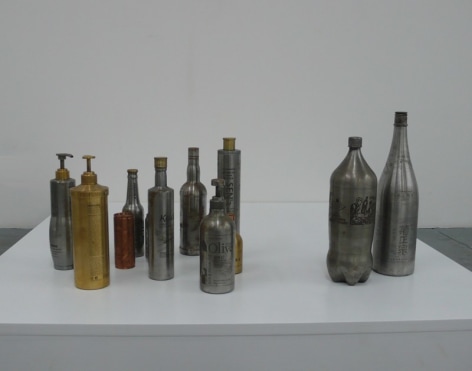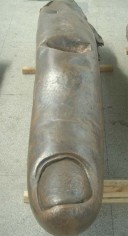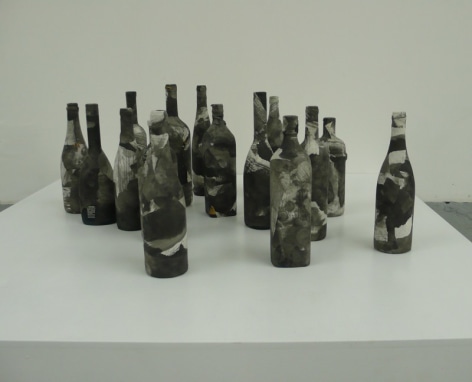Four years after the exhibition Alors, la Chine? held at the Centre Georges Pompidou, Paris posed this question about general developments in the world of contemporary art in China, the current exhibition focuses on sculpture which has had considerably less exposure than oil painting, video and photography. In part this is because fewer artists in the 1990s found three-dimensional expression to be suitable for the exploration of the social issues that were of such importance during this period. Since Chinese art of this period was all about breaking down barriers, however, many artists who started life as calligraphers, performance artists or photographers have found themselves irresistibly drawn to sculpture and the making of objects.
Included in the exhibition are works by Ai Weiwei, Zheng Guogu, Liu Jianhua, Zhang Huan, Shi Jinsong, Song Dong, Yin Xiuzhen, and Wang Tiande, none of whom with the exception of Shi Jinsong, would consider sculpture to be their primary medium. Without question, however, these versatile artists have produced some of the most provocative sculpture to have been produced in China in the last decade.
The human figure is only represented in fragmentary form by Zhang Huan’s Buddha Finger and United Hands by Song Dong and Yin Xiuzhen.Deeply moved by the destruction of cultural and religious assets in Tibet, Zhang Huan has created a series of monumental enlargements of sculptural fragments as memorials to this tragic loss. In their charmingly home-spun homage to their mutual attachment, Song Dong and Yin Xiuzhen use casts of their own hands, each holding a chopstick and supporting a miniature DVD screen documenting a bicycle ride around their neighborhood.
The sculptures of Shi Jinsong, Zheng Guogu and Wang Tiande represent objects rather than the human form. Shi Jinsong transforms well known logos into fearsome-looking implements in his Secret Book of Cool Weapons while Zheng Guogu and Wang Tiande use the form of the bottle for entirely different purposes. Trained in Chinese painting, Wang Tiande uses the form of the bottle as a sculptural support for layers of ink-soaked xuan paper. This contrasts dramatically with the group of twelve metal bottles by Zheng Guogu who first came to prominence in through the spontaneous style of his documentation of the youth culture of the small provincial city of Yangjiang where he lives. The permanence of these mundane objects, predicted to oxidize over a period of 2000 years, contrast with the ephemeral quality of urban life today.
Liu Jianhua and Ai Weiwei are both inspired by the long history of ceramics in Chinese history. Liu Jianhua was trained in Jingdezhen, the most important ceramic production in China with a history of over 2000 years. In Regular/Fragile he has moved away from the colorful, decorative appearance of his earlier work in favor of a monochromatic palette and imagery that recalls the excesses of European Baroque. Ai Weiwei rediscovered classical Chinese art when he returned to Beijing from New York in 1994. With his Duchampian sensibility, however, he questions while he admires, covering authentic Neolithic pots with brightly colored paint in Colored Vases and recreating a ruyi, a traditional Chinese auspicious symbol, as a colorful recreation of the human intestinal system.
巴黎蓬皮杜艺术中心举办《你好中国》(Alors, la Chine?)展的四年之后,提出这个有关中国当代艺术界普遍发展的问题,此次展览着眼于雕塑作品,一直未曾像油画、录像和摄影一样公开亮相。其中部分原因在于九十年代很少有艺术家感到三维表达方式能够适用于探索这段时期内具有重大意义的社会问题。尽管这一时期的中国艺术都是关于冲突阻碍的,但许多成为书法家、行为艺术家或摄影家的艺术家们却发觉自己不可抗拒地被雕塑所吸引。
此次展览包括艾未未、郑国谷、刘建华、张洹、史劲松、宋冬、尹秀珍和王天德的作品,其中除史劲松之外,没有一个人将雕塑视为自己的首要媒介。毫无疑问,这些多才多艺的艺术家们创作了中国过去十年来创作过的最具有争议的雕塑作品。
在张洹的《佛指》、宋冬和尹秀珍的《联手》中,人物形象仅仅是以片断的形势来表现。张洹深深被西藏文化和宗教遗产遭受的破坏所感动,创作了一系列将雕塑作品碎片加以放大的作品,以纪念这一悲剧性的损失。为了向彼此相互的依恋表达朴素的敬意,宋冬和尹秀珍采用了自己双手的翻模,每只手都抓着一只筷子,支撑着一个缩小的DVD屏幕,记录了在他们旁边骑过的一辆自行车。
史劲松、郑国谷和王天德的雕塑作品则表现了物品而不是人物形象。史劲松在《冷兵器秘笈》中将著名的标识转变成为看似可怕的器具,而郑国谷和王天德则将瓶子的样式用于完全不同的目的。王天德受过中国画的训练,他采用瓶子的形式当作多层浸墨宣纸的支撑雕塑。这同郑国谷创作的十二个纪念树瓶子形成了戏剧化的对比,后者最初是通过他在记录自己生活的阳江小城中年轻人文化时那种即兴的风格而著称。这些看似世俗的物件的永恒性——预示了超过两千年的氧化锈蚀——同当今都市生活的短暂性形成了对比。
刘建华和艾未未从中国漫长的制陶历史中得到了灵感。刘建好在景德镇学习,这是中国最重要的有着2000年历史的制陶中心。在《枕头上的头骨》中,他一反早期作品彩色富有装饰性的外观,青睐于单色调的影像,令人回想起欧洲巴洛克艺术。艾未未在1994年从纽约回到北京之后,重新发现了中国古典艺术。他有着杜尚式的敏锐,在钦慕的同时也提出了疑问,在《彩色花瓶》中,用鲜亮的色彩涂抹在新时期时代陶罐真品表面,并且重新创作了《如意》,一种中国传统的吉祥物,用色彩再现了人类的内脏系统。






